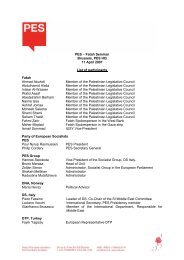Hedge funds and Private Equity - PES
Hedge funds and Private Equity - PES
Hedge funds and Private Equity - PES
Create successful ePaper yourself
Turn your PDF publications into a flip-book with our unique Google optimized e-Paper software.
156<br />
2. Market transparency – a common interest<br />
We have seen from part I <strong>and</strong> part II that HF <strong>and</strong> PE industries are characterised by an extreme<br />
lack of transparency, information asymmetry <strong>and</strong> lack of disclosure on all essential activities.<br />
In our modern European societies, this is in direct contradiction to the overall, general state of<br />
play of fundamental transparency in the real economy, as a basis for participation <strong>and</strong> responsibility<br />
of our people. The Nobel prize winner in economics, professor J. Stiglitz has shown how<br />
asymmetric information makes the market economy function ie inefficiently <strong>and</strong> certainly not optimally.<br />
Negative, systemic implications are created by HFs <strong>and</strong> PEs moving companies from<br />
transparency <strong>and</strong> disclosure in stock markets <strong>and</strong> public companies to opacity <strong>and</strong> lack of disclosure<br />
in the private part of market economy.<br />
With the strong influence of LBO / PEF on financial markets <strong>and</strong> the adherent macro / micro<br />
risks, the dem<strong>and</strong> for stricter information <strong>and</strong> transparency in these sectors is growing. Furthermore<br />
investors in LBO / PEF are no longer only very wealthy investors, but partly private retail<br />
investors (directly) or financial institutions who serve the general public or special public groups<br />
(Pension Funds, other public Funds, Insurance companies etc.).The main risks about which information<br />
<strong>and</strong> transparency are badly needed are: high or even sometimes extremely high leverage,<br />
market value risks, operational / managerial risk, correlation between several risk factors, or collusion<br />
between participants.<br />
Until now there has been practically no direct regulation of LBOs (apart from exchange regulation<br />
<strong>and</strong> accounting rules) <strong>and</strong> very light indirect regulation through the banks / Investment Banks<br />
/ Prime Brokers. This indirect approach seems increasingly insufficient, because Investment<br />
Banks as Prime Brokers are strongly dependent in their business volumes <strong>and</strong> profits on PEF /<br />
LBO firms. They are also increasingly active in proprietary HF <strong>and</strong> LBO business.<br />
A necessary condition for EMH (efficient market hypothesis) to hold is that information is fully<br />
<strong>and</strong> equally disseminated to all market participants. The only way to get it is through full disclosure<br />
of positions <strong>and</strong> moves of the main market players. There are many circumstances where<br />
strategic agents have incentives to make short-run profit in playing a less than idealistic game.<br />
If their move is hidden, they may drive the market in a destabilising direction.<br />
After the 1987 Stock market crash, several models showed that ignorance of the motivations<br />
that initiated the market decline had led to a huge magnification of the crash. One recommendation<br />
of the Brady inquiry 83 was improving disclosure, apparently to no avail. This question is<br />
more relevant than empirical studies showing that mean-reverting processes on equity, bond <strong>and</strong><br />
foreign exchange markets have a longer time span than the horizon of market players like hedge<br />
<strong>funds</strong>. Therefore the disclosure of proprietary trading of hedge <strong>funds</strong> would be nothing but<br />
setting the right conditions for market discipline. Those who oppose it have other motivations<br />
than improving market efficiency.<br />
As much as tougher competition between hedge <strong>funds</strong> crowds out st<strong>and</strong>ard market-neutral<br />
strategies increase efficiency <strong>and</strong> drive prices <strong>and</strong> HF-yields downwards, shifts to more exotic<br />
styles arise in search for higher excess returns. HFs have become even more opaque while they<br />
have been holding assets with hazardous <strong>and</strong> infrequent valuation via the use of event-driven<br />
situations, the buying of distressed securities <strong>and</strong> the investment in private equity. Low-frequency<br />
skewed distributions of returns make the computation of volatility unreliable. Value-at-Risk models<br />
used by banks 84 to internally assess credit risk are not suited for hedge <strong>funds</strong>. Running stress<br />
tests <strong>and</strong> disclosing results to market supervisors should be a minimal requirement.<br />
83 After the Stock market crash of October 1987, a US presidential task force on market mechanisms, chaired by Senator Nicholas Brady,<br />
was set up to investigate on what went wrong. It was known as the Brady Commission. Among other disturbing factors, the inquiry revealed<br />
the strength of b<strong>and</strong>wagon effects triggered by portfolio insurance.<br />
84 These are non-anticipated risk measurement models used by banks as supervisors require them capital adequacy provisions. More precisely,<br />
it is the value of losses that could be over passed only a certain % of time. For instance, the value of losses that could be over passed<br />
only 1% of working days.




